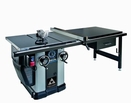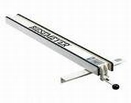How to Fine-Tune Your Table Saw
 Let’s face it, many of us run our table saws through the ringer. As the central piece of most woodshops we work them like our beast of burden, we force them through every rigor of woodshop life and rarely give them even the smallest nuzzle of thanks. As such, it’s really no surprise that our table saws can get a little beat up, they can fall out of alignment and begin to produce cuts with a poor man’s precision (pardon the expression). All this requires, though, is a bit of good-old-fashioned time and a bit tender loving care.
Let’s face it, many of us run our table saws through the ringer. As the central piece of most woodshops we work them like our beast of burden, we force them through every rigor of woodshop life and rarely give them even the smallest nuzzle of thanks. As such, it’s really no surprise that our table saws can get a little beat up, they can fall out of alignment and begin to produce cuts with a poor man’s precision (pardon the expression). All this requires, though, is a bit of good-old-fashioned time and a bit tender loving care.
Beginning With Your Blade:
 It’s fairly simple to see when your table saw blade needs to be aligned. If misaligned, your overall cutting accuracy with suffer and you will likely see burn marks about your cut-lines. You may also experience something not unlike planer snipe where you’ll lose a bit more material than intended near the end of your cut.
It’s fairly simple to see when your table saw blade needs to be aligned. If misaligned, your overall cutting accuracy with suffer and you will likely see burn marks about your cut-lines. You may also experience something not unlike planer snipe where you’ll lose a bit more material than intended near the end of your cut.
To remedy said blade alignment issue, that is exactly where you’ll want to start – at the blade. First, take a real good look at the thing; after all, the component is pretty darn important to your table saw. Before cleaning, sharpening, or anything else, you’ll want to make sure that the blade is totally, completely, perfectly flat. To do this, simply watch the blade come to a stop after disengaging the saw. As the blade slows, it should remain perfectly straight, if there is any wobble in the blade it will have to be replaced. NOTE: A loose blade may also cause a bit of wobble; if you’re loose, tighten it up a bit and spin again. If you still wobble after tightening, replace the blade.
If your present blade is flat, you want to also ensure that it is clean and clear of pitch (or that sticky build-up that accrues with each cut). Soaking your blades in oven-cleaner, toilet bowl cleaner, kerosene, or mineral spirits will remove pitch build-up. Whichever solution you use though, wipe or scrub the blade with a non-abrasive cloth to avoid scratching the blade and remember that these solutions are highly flammable. Be always cautious when working with them and always cautious when working with saw blades. If you’re pitch-free, you may simply wipe the blade with a lint-free cloth and a water-diluted household cleaner. Now, you’ll also want ensure your blade is sharp; if you have the skill and equipment to sharpen it yourself then that is tremendous, if not, your blade distributor should be able to sharpen it for you for a small fee. If you have any chips, missing teeth, or if the blade is in generally bad condition, you should replace it.
Aligning the Blade to the Miter Slot:
After tightly and properly installing a flat, clean, sharp blade into your saw, you now need to make sure the blade is set parallel to the saw’s miter slots. To do this, raise the blade as high as possible and pick a specific tooth on the blade as a reference point. Move (or rotate) the blade forward until your reference tooth is level with the front end of the saw table. Measure and note the distance between your reference tooth to the miter slot. Now, reverse rotate the blade until your reference tooth is level to rear of the saw table and measure and note again. If there is a discrepancy in the distances, simply adjust the saw motor accordingly (and as per your manual) and repeat the measuring process until you are perfectly lined up. You may also want to ensure that your miter gauge is aligned to the miter slot and can move freely between all positions.
Fence Alignment:
 Our next step is checking the alignment of the saw’s rip fence (because misalignment of the rip fence can cause kickback, sloppy cutting, and inaccurate angles, this part of the process is particularly important). By virtue of the blade now being perfectly aligned with the miter slot, you can confidently align the fence to the miter slot as well. Take a framing square or straight-edge that is at least as long as your fence and stand it up inside the miter slot. Slide the fence toward the straight edge until they are firmly pressed together. Closely inspect the space between the fence and straight edge to confirm there are no gaps. Where gaps appear, simply adjust your fence to correct them (see your manual for any further specifics). It is also recommended that you check the fence’s locking mechanism to ensure it can brace some lateral pressure – this will ideally ensure that it won’t slide during the pressure of use.
Our next step is checking the alignment of the saw’s rip fence (because misalignment of the rip fence can cause kickback, sloppy cutting, and inaccurate angles, this part of the process is particularly important). By virtue of the blade now being perfectly aligned with the miter slot, you can confidently align the fence to the miter slot as well. Take a framing square or straight-edge that is at least as long as your fence and stand it up inside the miter slot. Slide the fence toward the straight edge until they are firmly pressed together. Closely inspect the space between the fence and straight edge to confirm there are no gaps. Where gaps appear, simply adjust your fence to correct them (see your manual for any further specifics). It is also recommended that you check the fence’s locking mechanism to ensure it can brace some lateral pressure – this will ideally ensure that it won’t slide during the pressure of use.
Squaring Your Blade to the Saw Table:
Now, to ensure your blade is square to the table, simply set your saw’s arbor angle to zero degrees. Using a small framing square or a layout square, ensure the blade forms an exactly ninety degree, or square, angle with the saw table. If you don’t find a perfect ninety degree angle, adjust the saw’s zero degree stop in the appropriate direction until you obtain a perfect square angle. Specifics for this procedure will also be more completely outlined in the saw’s manual.
Inspecting Your Throat Plate:
Now that your blade is square and your fence and blade are aligned to the saw’s miter slot, you’ll want to double check the level of your throat plate. The throat plate should lie at or just below the level of the saw table, if it sits above this level the throat plate may interfere with the stock as it moves toward the blade.
To most effectively check the height of the throat plate, slide your framing square or straight edge across it to ensure it doesn’t catch. If the plate extrudes past the level of the table, use the adjustment screws on the plate to lower it. As with the blade, check here for cleanliness as well. Saw dust is a retched creature with a tendency to build-up.
And now, after all this is said and done, you and your table saw should be ready for just about anything. With just a few steps and a little bit of patience and effort, your table saw is now aligned with superior precision and ready to tackle your wildest woodworking projects.













